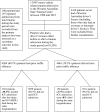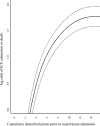The journey from traffic offender to severe road trauma victim: destiny or preventive opportunity?
- PMID: 25902197
- PMCID: PMC4406520
- DOI: 10.1371/journal.pone.0122652
The journey from traffic offender to severe road trauma victim: destiny or preventive opportunity?
Abstract
Background: Road trauma is a leading cause of death and injury in young people. Traffic offences are common, but their importance as a risk indicator for subsequent road trauma is unknown. This cohort study assessed whether severe road trauma could be predicted by a history of prior traffic offences.
Methodology and principal findings: Clinical data of all adult road trauma patients admitted to the Western Australia (WA) State Trauma Centre between 1998 and 2013 were linked to traffic offences records at the WA Department of Transport. The primary outcomes were alcohol exposure prior to road trauma, severe trauma (defined by Injury Severity Score >15), and intensive care admission (ICU) or death, analyzed by logistic regression. Traffic offences directly leading to the road trauma admissions were excluded. Of the 10,330 patients included (median age 34 years-old, 78% male), 1955 (18.9%) had alcohol-exposure before road trauma, 2415 (23.4%) had severe trauma, 1360 (13.2%) required ICU admission, and 267 (2.6%) died. Prior traffic offences were recorded in 6269 (60.7%) patients. The number of prior traffic offences was significantly associated with alcohol-related road trauma (odds ratio [OR] per offence 1.03, 95% confidence interval [CI] 1.02-1.05), severe trauma (OR 1.13, 95%CI 1.14-1.15), and ICU admission or death (OR 1.10, 95%CI 1.08-1.11). Drink-drinking, seat-belt, and use of handheld electronic device offences were specific offences strongly associated with road trauma leading to ICU admission or death--all in a 'dose-related' fashion. For those who recovered from road trauma after an ICU admission, there was a significant reduction in subsequent traffic offences (mean difference 1.8, 95%CI 1.5 to 2.0) and demerit points (mean difference 7.0, 95%CI 6.5 to 7.6) compared to before the trauma event.
Significance: Previous traffic offences were a significant risk factor for alcohol-related road trauma and severe road trauma leading to ICU admission or death.
Conflict of interest statement
Figures




Similar articles
-
Trauma admissions to the intensive care unit at a reference hospital in Northwestern Tanzania.Scand J Trauma Resusc Emerg Med. 2011 Oct 24;19:61. doi: 10.1186/1757-7241-19-61. Scand J Trauma Resusc Emerg Med. 2011. PMID: 22024353 Free PMC article.
-
Effect of an injury awareness education program on risk-taking behaviors and injuries in juvenile justice offenders: a retrospective cohort study.PLoS One. 2012;7(2):e31776. doi: 10.1371/journal.pone.0031776. Epub 2012 Feb 15. PLoS One. 2012. PMID: 22355394 Free PMC article.
-
Trauma admissions into the intensive care unit and outcome of care in a tertiary health facility.Niger J Med. 2014 Oct-Dec;23(4):296-301. Niger J Med. 2014. PMID: 25470854
-
Direct transport vs secondary transfer to level I trauma centers in a French exclusive trauma system: Impact on mortality and determinants of triage on road-traffic victims.PLoS One. 2019 Nov 21;14(11):e0223809. doi: 10.1371/journal.pone.0223809. eCollection 2019. PLoS One. 2019. PMID: 31751349 Free PMC article.
-
Global trauma: the great divide.SICOT J. 2015 Jul 21;1:19. doi: 10.1051/sicotj/2015019. SICOT J. 2015. PMID: 27163075 Free PMC article. Review.
Cited by
-
Driving offences and risk of subsequent crash in novice drivers: the DRIVE cohort study 12-year follow-up.Inj Prev. 2022 Oct;28(5):396-404. doi: 10.1136/injuryprev-2021-044482. Epub 2022 Mar 31. Inj Prev. 2022. PMID: 35361665 Free PMC article.
-
Predicting Crashes Using Traffic Offences. A Meta-Analysis that Examines Potential Bias between Self-Report and Archival Data.PLoS One. 2016 Apr 29;11(4):e0153390. doi: 10.1371/journal.pone.0153390. eCollection 2016. PLoS One. 2016. PMID: 27128093 Free PMC article.
References
-
- [No authors listed] On the road: accidents that should not happen. Lancet 2007; 369:1319 - PubMed
-
- Global status report on road safety: time for action Geneva, World Health Organization, 2009. Available: (www.who.int/violence_injury_prevention/road_safety_status/2009). Accessed 27 Aug 2014.
-
- Butler JS, Burke JP, Poynton AR. Focused road-safety initiatives urgently required. Lancet 2007; 369:2160 - PubMed
Publication types
MeSH terms
Associated data
LinkOut - more resources
Full Text Sources
Other Literature Sources
Medical

